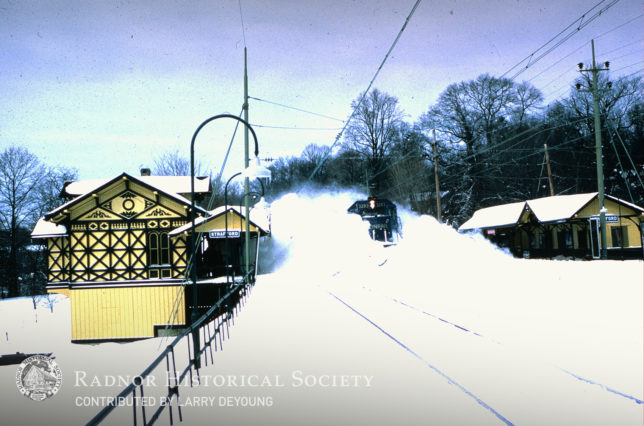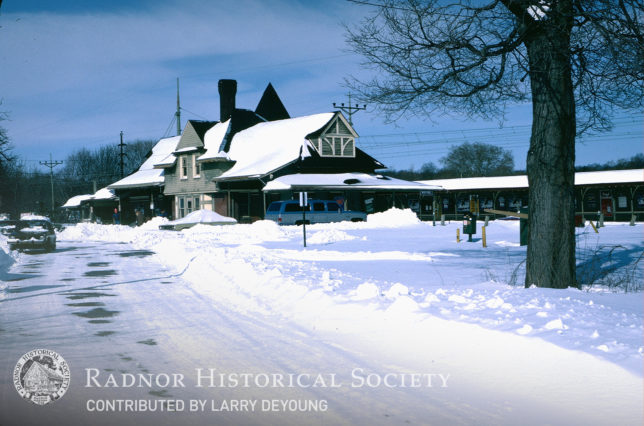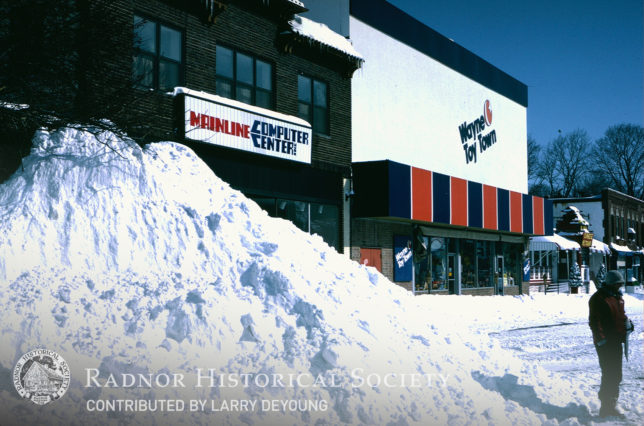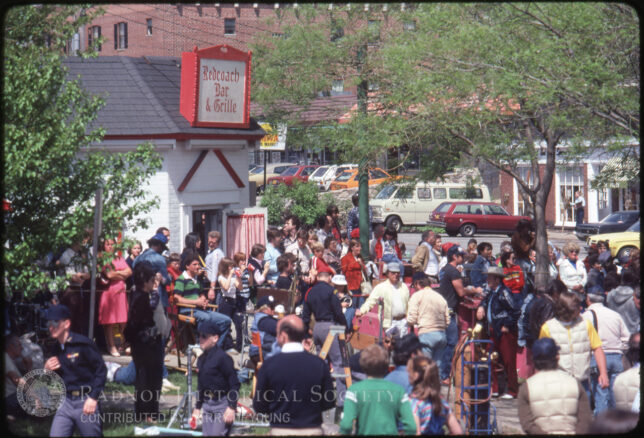Contributed by Larry DeYoung
Big Snow
My wife, Joyce, and I moved to the Main Line from Ohio in late summer 1978. She had been recruited to work in the labs at Wyeth in Radnor and I came as an “unemployed dependent,” anticipating that I’d find work here in some capacity. By November, I was working in the Marketing Department at Conrail in Center City and commuting to Suburban Station daily on the Paoli Local from Strafford. Both of us grew up in the snow belt along the shores of Lake Erie and expected much less severe winter weather here. As you will see, we began to have our doubts.
In February 1979, there was a heavy snow that came on a Saturday, which was good for nearly everyone concerned. As a new railroad employee, I decided to walk over to Strafford to see how the railroad coped with a heavy snowfall. Being a hobby photographer, I took my camera and was able to snap a few snowfall Kodachromes (remember them?) including one of a Conrail locomotive running as a snowplow on the Main Line. A man across the tracks from us saw that I had a camera and came over to inquire. He turned out to be a language professor at Bryn Mawr College, and through that contact we became friends and remain so to this day. But with that heavy snow I had my first inkling that maybe southeastern Pennsylvania was not in the tropics after all!
On October 10 that same year, my boss at Conrail offered to take me to lunch at Top of Center Square for my birthday. It was a great idea; I’d get to see the bird’s eye view of Philadelphia for the first time. But it was not to be. It snowed so hard that no one could see anything, not even William Penn’s statue, from the high-rise restaurant! In all my years in the snow belt I had never seen a significant snowfall on my birthday. Incredible. My doubts were reinforced.
But then things slacked off for a while. The next few winters were free of significant or surprising unseasonable snowfalls. But that was rectified in February 1983. We awoke on February 12, again a Saturday, to a huge snowfall. I was then manager of (freight) service development at Conrail and tried to stay on top of operations. One way I did that was by having a scanner tuned to the railroad’s frequency. I could hear conversations between train crews and line-side offices. I turned the scanner on that morning and heard a conversation between Win Gross, the switch tower operator at Paoli, and a Conrail freight running between Enola Yard in Harrisburg and Pavonia Yard in Camden. It became clear that the train had made an emergency stop in Paoli because the air brakes had been triggered by the hoses striking a snow bank across the tracks. This meant that the train would arrive in Strafford only after the disconnected hoses were secured and the air supply recharged on the train, a minimum of thirty minutes.
With the possibility of a “train-in-snow” photograph in mind, I suggested to Joyce that we head over to the Strafford station. We bundled up and trudged through the deep snow, sometimes walking in the streets as there was very light traffic. When we arrived on the platform at Strafford, a contractor’s crew was busily clearing the snow around the station. After a few minutes, a SEPTA eastbound train pulled in and the departed toward Center City. Shortly thereafter, a low rumbling anticipated the passage of the Conrail freight on the completely snow-covered inside track. The train passed the station, throwing a huge rooster tail of snow as it approached us at about 40 miles per hour. I took several photos in sequence, all of which would prove to be successful, and then “ducked and covered” to protect myself and my camera from the snow being thrown up by the train. Joyce wasn’t as quick to realize what was going to happen, and a subsequent photo shows her with snow behind her glasses as she had taken the snow plume head-on. The contractors clearing the platforms had to start over. Only later did it occur to me what an act of faith it is on the part of train crews to run through snow completely obscuring the track: they have no confirmation that the track is even there, and it is their only means of “steering” their train!
After we brushed the snow off ourselves, the two of us decided to walk into Wayne to see how the business district was coping with the nearly two feet of snow. If I recall correctly, we walked along Strafford Avenue, Eagle Road, and West Avenue. One photo shows the intersection of West Avenue and North Wayne, with a huge embankment of snow in the foreground. Another shows the Wayne Station. Several slides show snow along Lancaster Pike, with an enormous pile in front of Wayne Toy Town. It was a memorable snowfall, one that competes in our memories with any we experienced growing up “west of the Alleghenies.” Later, one of my photos of the freight train at Strafford was chosen by Conrail for inclusion in its employee calendar and was used by a Marketing Department unit for its customer holiday greeting card.
Movie Making
In 1981, word came in The Suburban that 20th Century Fox would be filming “Taps” in Wayne. The movie used Valley Forge Military Academy and College as the setting for its story, and used Wayne as the location of its school town. My wife, Joyce, and I decided to walk over on a Saturday and see if we could catch a glimpse of George C. Scott, Timothy Hutton, or other stars who were featured in the production, or see what was being filmed in the streets. We succeeded on both counts, and were entertained by the complex process of multiple “takes” necessary in the production of a feature film. One incident affected the full process of filming, when a police vehicle in the filming slid into a street light pole at the corner of West Avenue and North Wayne Avenue, and subsequent takes had to account for the damage to the pole and to the vehicle. We also noted that the director for some reason had determined that a SEPTA train should be arriving in the scene, and so had to repeatedly back up west and then, with perfect timing, arrive at Wayne Station as the vehicles were being filmed. It always struck us that the easy way out would have been to show no train at all. Who would care? Ironically, having spent the better part of that afternoon watching the filming, we have never actually seen “Taps”!
There is a Car in My Yard!
From 1978 through 1987 Joyce and I lived on South Devon Avenue in one of the raised ranch houses that sit in facing pairs on the east side of the road, northeast of Donna Lane. We were sound asleep one night when our dreams were altered by unusual sounds. I think Joyce awoke first, and she asked if I had heard “that.” I had, but she was more motivated than I and went to look out the front of the house. There, near our front “picture” window was a Volkswagen Beetle, thoroughly incapacitated. She got on the phone to the Radnor Police dispatcher while I kept an eye on the vehicle and watched as one of the occupants, both of whom were out of the car, ran away toward Clover Lane and Warren Filipone Park. As our next door neighbor, a Villanova faculty member, came out of his house, the other car occupant collapsed to the ground. Meanwhile, Joyce was telling the dispatcher that we had a car in our yard, which was literally true, but the dispatcher was having a hard time treating the call as serious, thinking perhaps that he had either a drunk or a prankster on the line. Joyce finally made it clear that this car was not parked in our driveway, that it was literally in our yard and had been driven there by someone who was still nearby.
Soon, Radnor Police arrived to assess the situation. At some point the second occupant of the car returned, and the police were then trying to determine 1) who had been driving, and 2) if they needed medical attention. They insisted that they did not, but when they were asked to submit to evaluation for intoxication, they began to verbally abuse the officers. Our neighbor, Bill, a former Catholic brother, would later observe to me that the police were very patient. “I would have put their lights out,” he said. Meanwhile, a tow truck arrived and after the police took the still resisting occupants away in the patrol car (they thought they could drive the VW away), the Beetle was dragged out of our yard and hauled off to where no longer operable cars go.
The next morning, we reconstructed what must have happened. The two young men, obviously thoroughly intoxicated, had come careening down South Devon Avenue heading northeast toward Conestoga Road and failed to make the modest left hand curve between Arbordale Road and Donna Lane. Their Beetle climbed the curb and entered Bill’s yard where it hit a cherry tree (the sounds Joyce and I had heard in our dreams), spun 360 degrees, and came to rest in our yard. They hit the tree hard enough that the top of the windshield impacted the tree, and the windshield came out! That the two young “perps” were essentially uninjured (or at least thought they were) testifies to the state of their incapacity.
The next day, Bill gathered two trash barrels of Volkswagen parts for the week’s trash pick-up, and I found several parts in our yard, including a headlight rim that I discovered behind a shrub under our dining room window. I think it is safe to say that VW never moved again under its own power. That same next day, there was a parade of Radnor Police cars past our houses as every officer, it seemed, came by to see the scene of “the car in the yard.” The tree survived that year, but the next spring, when it came time to leaf out and bloom, the tree was dead, having been killed by an errant Volkswagen.
Larry and Joyce DeYoung live in Easttown where they are assistant editors of the Tredyffrin Easttown History Quarterly and Larry is chairman of the board of Tredyffrin Easttown Historical Society. Joyce is retired from her pharmaceutical career and Larry says he is “mostly” retired from the rail freight business.























